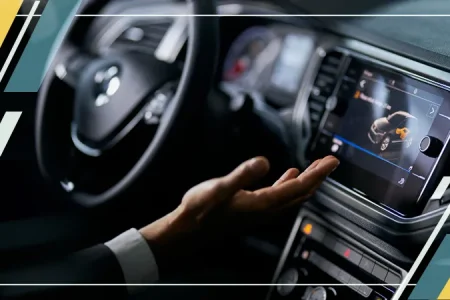In the fast-paced world of automotive technology, communication plays a pivotal role in shaping the future of transportation. As the automotive industry rapidly evolves, the integration of cutting-edge communication technologies is becoming increasingly crucial. From enhancing safety features to improving vehicle-to-vehicle interactions, automotive communication technology is at the forefront of this transformation. In this blog, we delve into the realm of automotive communication, focusing on high-speed communication technologies, trucking communication solutions, and the broader spectrum of information communication technologies.
Benefits of Automotive Communication Technology
Given below are the advantages of automotive communication technology:
- Improved Safety: Reduces the risk of accidents by facilitating better communication between vehicles and infrastructure.
- Enhanced Efficiency: Optimizes traffic flow and vehicle performance, leading to reduced travel times and fuel consumption.
- Increased Convenience: Provides advanced features and services that enhance the overall driving experience.
Key Components of Automotive Communication Technology
Automotive high-speed communication technologies are revolutionizing the way vehicles interact with each other and their surroundings. These advanced systems enable rapid data exchange between vehicles and infrastructure, enhancing safety and driving efficiency. Technologies such as Vehicle-to-Everything (V2X) communication and 5G connectivity are setting new standards in the industry.
- Vehicle-to-Everything (V2X) Communication: V2X technology enables vehicles to communicate with other vehicles, infrastructure, and even pedestrians. This real-time exchange of information helps in preventing accidents, reducing traffic congestion, and improving overall traffic management. For instance, V2X communication can alert drivers about upcoming road hazards or changes in traffic signals, leading to a smoother and safer driving experience.
- 5G Connectivity: The rollout of 5G networks is a game-changer for automotive communication. With its ultra-low latency and high-speed data transfer capabilities, 5G enhances vehicle connectivity, enabling faster communication between autonomous vehicles and their control systems. This technology supports advanced features like real-time navigation updates, remote vehicle diagnostics, and seamless infotainment experiences.
- Dedicated Short-Range Communications (DSRC): A communication protocol specifically designed for automotive environments, allowing for low-latency and high-speed data exchange.
Automotive Trucking Communication Technology
In the realm of automotive trucking, communication technology is pivotal for streamlining operations and enhancing fleet management. Trucking communication solutions are designed to address the unique challenges faced by commercial transportation, such as route optimization, real-time tracking, and driver safety.
- Fleet Management Systems: Advanced fleet management systems leverage communication technology to provide real-time data on vehicle location, fuel consumption, and driver behavior. These systems enable trucking companies to optimize routes, reduce operational costs, and improve overall fleet efficiency. For example, GPS tracking and telematics can help in monitoring driver performance and ensuring compliance with regulatory requirements.
- Telematics and Connectivity: Telematics technology integrates communication systems within trucks to monitor vehicle health, track cargo, and facilitate communication between drivers and dispatchers. This connectivity enhances operational efficiency and ensures timely delivery of goods. Additionally, telematics systems can provide valuable insights into maintenance needs, helping prevent breakdowns and extend the lifespan of the fleet.
Information Communication Technologies in the Automotive Sector
Information communication technologies (ICT) encompass a wide range of tools and systems that facilitate the exchange and management of information. In the automotive sector, ICT plays a crucial role in integrating various communication technologies to create a cohesive ecosystem.
- Cloud Computing: Cloud-based solutions enable the storage and processing of vast amounts of data generated by automotive communication systems. This technology supports features such as over-the-air updates, data analytics, and remote vehicle monitoring. By leveraging cloud computing, automotive manufacturers can offer enhanced services and improve the overall user experience.
- Artificial Intelligence (AI) and Machine Learning: AI and machine learning algorithms are increasingly being used to analyze data from automotive communication systems. These technologies help in predicting maintenance needs, optimizing traffic flow, and personalizing in-vehicle experiences. For example, AI-driven systems can analyze driving patterns to provide tailored recommendations for improving fuel efficiency and safety.
Applications of Automotive Communication Technology
Here are some applications of this technology in the automotive sector:
- Safety and Driver Assistance: Enhances safety through features like collision warning, automatic braking, and lane-keeping assistance.
- Traffic Management: Helps in optimizing traffic flow and reducing congestion by providing real-time information about road conditions and traffic signals.
- Autonomous Vehicles: Supports the operation of self-driving cars by enabling real-time communication between vehicles, infrastructure, and control systems.
- Infotainment and Connectivity: Offers advanced entertainment options, including real-time updates, seamless navigation, and integration with smartphones and other devices.
Conclusion
Automotive communication technology is driving significant advancements in the transportation industry. High-speed communication technologies, trucking communication solutions, and information communication technologies are all contributing to a safer, more efficient, and more connected driving experience. As these technologies continue to evolve, we can expect even greater innovations that will shape the future of automotive transportation. Embracing these advancements will not only enhance vehicle performance but also pave the way for a more connected and intelligent automotive ecosystem.
